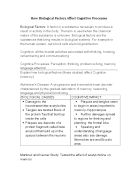PET scans are considered to be a valuable way of studying cognitive processes. They are frequently used to identify areas of brain activity and this knowledge can help researchers to identify areas of the brain which are responsible for specific functions, e.g. the link between the hippocampus and the storage and retrieval of explicit memories. They also allow researchers to identify the relationship between cognition and behaviour in a scientific and carefully controlled way. In addition, PET scans can be used to detect changes over time to the brain and may help to identify the onset of a disorder such as Alzheimer’s disease. In doing so, it may be possible to start treatment early and reduce the damaging effects of such a disease on an individual.
Another brain imaging technique used to study cognitive processes are fMRIs. This type of fMRI scanning has been used in numerous studies including ones which examine brain activity and structure, the effects of brain damage and the monitoring of brain tumours. fMRI scans work by detecting and measuring changes in blood oxygenation and flow to the brain. The measurement of this is called the blood-oxygen-level-dependent (BOLD) signal and shows up on the scan as a variety of different colours. The brighter the colours (e.g red changing to yellow), the more activity can be said to be occurring in that particular part of the brain.
FMRIs have been used in research such as that carried out by Kozel et al. (2011, in press) who aimed to test whether deception could be identified using fMRI scans. The participants in the experiment took part in a mock crime where they stole either a ring or a watch. While undergoing an fMRI, the subjects denied taking either object, therefore telling the truth on one response and lying on another. On average, the researchers were able to correctly differentiate truthful responses from deceptive responses 91.5% of the time as the activity in the part of the brain responsible for deception displayed brighter colours on the fMRI than other areas.
FRMIs are considered to be easier to carry out that PET scans and as a result are generally used more frequently in psychological research. As they provide a three dimensional image of the brain they are able to show activity as it occurs, allowing researchers to make the link between brain function and behaviour. FMRIs also have a higher resolution than PET scans, allowing researchers to gather more reliable data about cognitive processes as they occur.
Whilst both PET and fMRI scans allow us to identify activity in areas of the brain, researchers need to be careful not to jump to the conclusion that an area of activity is directly linked to a cognitive process or behaviour. For example, the amygdala has been identified as being responsible for memory but has also been linked with emotional arousal such as fear. As parts of the brain are interconnected, it would not be considered reliable for a researcher to jump to the conclusion that two factors are undeniably linked without conducting further research. Another criticism of using scans to investigate cognitive processes is that the technology is not yet sophisticated enough to detect very subtle brain activity. Whilst fMRI scans provide images at a higher resolution, they are currently unable to detect small levels of activity which may add to our knowledge of cognitive processes. As technology develops, a wider picture of how the brain works will be developed however our current knowledge is still quite limited.







